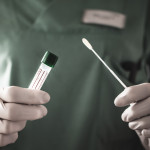Johnson & Johnson (J&J) has announced that it is investing $30 million in a new test that could detect—and help doctors treat—a variety of cancers from a simple blood draw, according to reporting by Yahoo Canada News. While experts concede that such a test is still years away, some are predicting that it could revolutionize cancer detection and treatment.
Several years ago, doctors at Massachusetts General Hospital created an assay designed to count the number of cancerous cells that were spreading from invasive and aggressive tumors. The test, called CellSearch, is now made and sold by a J&J subsidiary called Veridex. While it has helped somewhat in assessing the behavior and spread of serious metastatic tumors—such as colorectal cancer—it is not particularly precise.
The new test, to which J&J is now pouring new money, aims to be far more accurate and provide much richer detail.
In addition to counting cells, the experimental assay can capture cancer cells and allow doctors to understand exactly how the cells are behaving and developing. This new level of precision could help guide in almost real time how to manage cancer treatment without invasive biopsies or cumbersome and expensive computed tomography (CT) scans.
“This is like a liquid biopsy,” Daniel Haber, MD, chief of Massachusetts General Hospital’s cancer center and one of the test’s inventors, told Yahoo.
“If you could find out quickly, ‘This drug is working, stay on it,’ or ‘This drug is not working, try something else,’ that would be huge,” Haber continued.
Experts caution that similar tests have not panned out in the past. One, GeneSearch, was originally lauded for its promise in helping detect the spread of breast cancer cells to lymph nodes. It was later scrapped, however, because it was very expensive and too often gave false positive results.
Experts say that it could take years to test the new assay against the various cancers to which it would be applied. It is also not clear how much it will cost, nor what the machine that will run the assay will look like or how it will function.
Despite this uncertainty, Greg Vrettos, a 63-year-old lung cancer survivor from Durham, New Hampshire, has already benefited from an early prototype of the test. A previous biopsy had collapsed his lungs four years ago, which illustrates why biopsies can be both dangerous and unpleasant. The new assay, however, along with CT scans, has given Vrettos’s doctors a noninvasive tool to help choose the best treatment and keep him on it—and alive—for several years now.
“I think [the new assay is] going to be revolutionary,” Vrettos said.
Advertisement
Advertisement
Advertisement






Comments
Comments